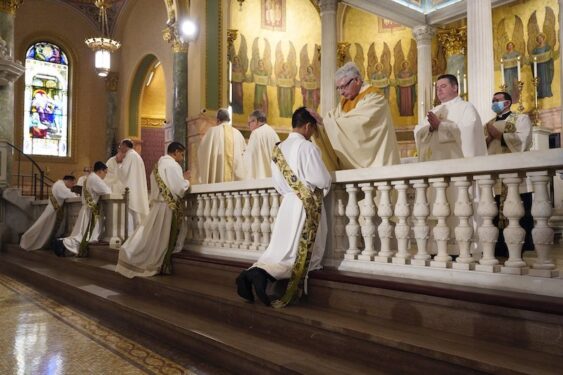By Mark Pattison
WASHINGTON (CNS) — The annual report of new priests commissioned by the U.S. bishops shows that among those who responded, a shrinking number are white, a sign of the “little-C” catholic nature of the Catholic Church.

Among ordinands — the term used for seminarians slated for ordination this year — the percentage who are white is 63%. Last year, the percentage who were white was 65%, and in 2020, 67% of ordinands were white. In religious orders, new white priests are at a plurality of 49%.
This was just one of the findings of the study “The Class of 2022: Survey of Ordinands to the Priesthood,” conducted for the bishops by Georgetown University’s Center for Applied Research in the Apostolate, released May 2.
As calls come from many corners for the U.S. government to cut student debt, the survey revealed that 58% completed an undergraduate degree or a graduate degree before entering the seminary. But they also brought significant student debt with them as they entered the seminary. That debt, on average, was $29,550, CARA said.
“Between entering seminary and ordination, the average amount of debt carried by responding ordinands in religious institutes decreased by 53% and the average amount of debt carried by responding diocesan ordinands decreased by 4% since entering the seminary,” CARA reported.
“Those who had educational debt were not delayed entrance by that debt with the exception of four respondents who were delayed between one and two years.”
The ordinands pursued a wide variety of academic disciplines before responding to the call to priesthood. Seven fields got at least 10% of respondents’ answers, with none getting more than 17%. In descending order of choice, they were philosophy, liberal arts, theology, business, science or math, education and engineering.
There was a strong tendency to work in education before joining the seminary, constituting 16% among all ordinands; the next highest profession was at 9%.
Distinct minorities, both among entering diocesan and religious priesthood, went to Catholic schools at any level: elementary, high school or and college. Even smaller were the numbers for those not born in the United States. But majorities went to their parish’s religious education program, by close to a 2-to-1 margin.
In their parishes, 74% served as altar servers before entering the seminary, and 51% served as lectors, the only ministries that garnered affirmative replies by more than half of the respondents.
Three-eighths of the respondents served as extraordinary ministers of Holy Communion or catechists. Three in ten served in campus or youth ministry. And a quarter had served as confirmation sponsors or godfathers, or as a cantor or in music ministry.
The largest percentage of diocesan ordinands had gone to seminaries in the Midwest, while the greatest number of religious seminarians had done their seminary studies in the South.
Older vocations are fairly scarce. CARA said only 14% were ages 41 or older when they were ordained. Men ages 25-70 were set to be ordained this year, and the average age was 33.
The survey was administered Jan. 10-March 18. An invitation was sent by email to 419 identified ordinands. Follow-up emails were regularly sent to the ordinands who delayed their response. In all, 317 ordinands completed the survey, a 76% response rate. The respondents included 238 ordinands to the diocesan priesthood, a 75% response rate, and 79 ordinands to the religious priesthood, a 25% response rate.
Three in five responding ordinands are white, while 22% were Hispanic, 11% is Asian/Pacific Islander or Native Hawaiian. Only 4% were Black. Foreign-born ordinands made up 26% of the respondents, consistent with surveys dating back to 1999, when 28% of respondents were foreign-born.
